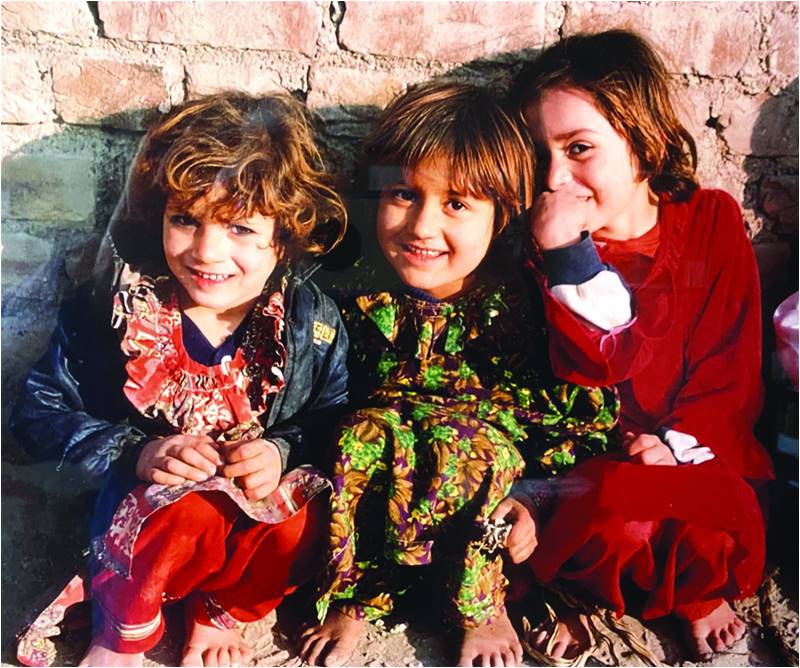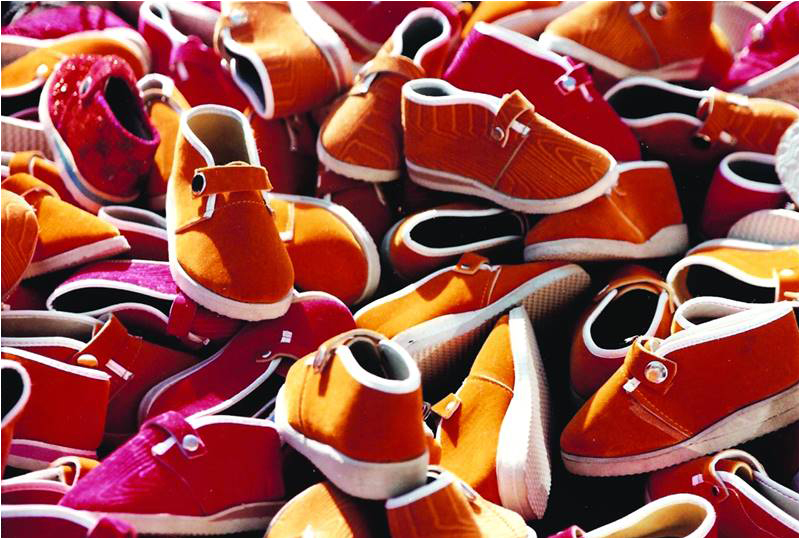
Yehee kaha thaa meri aankh dekh sakti hai
Toe mujh pei toot parha saara sheher-nabeena
When I dared to say my eye can see things that others refuse to see
The entire city of the blind gathered to lynch me
(Ahmad Faraz)
A few years ago during one of my deliberately aimless wanderings in Peshawar I saw a street vendor selling baby shoes on a sidewalk in Qissa Khani Bazaar. On a cotton shawl spread on the sidewalk, there were hundreds of baby shoes in vividly inviting colours. As I snapped a picture I was not thinking about the significance of shoes in a country where a good number of children go shoeless.
In the same city in one of the areas of mud houses and unpaved dusty streets I saw a bunch of children playing in their bare feet. Their bright and sprighty – if dusty and dirty – faces showed uninhibited exuberance that only children can muster and exhibit. As they skipped rope and chased each other, stirring a small cloud of dust in their wake, they were in a world that was galaxies away from the pile of colorful shoes on the pavement in the Street of Story Tellers. The pile of colourful shoes and the barefoot children underscore the plight of the children around the world.
Children suffer from poverty and exploitation the world over. Even in the rich industrialized societies, physical and sexual abuse of children is more common than one would think. In the third world poor countries’ children are not only exposed to the abuses seen in the West, they also are forced into the roles of bread earners, warriors, sex workers and petty thieves.

Many insurgency-based movements recruit children to bear arms for the dubious causes of their leaders. In the jungles of South East Asia and in the Philippine, children as young as ten, are forced to become child soldiers and end up cannon fodder for causes they do not understand or comprehend. During the decade old Iran-Iraq war in the 1980s, Iranian teenage boys were regularly sent to the front to their certain death. In Afghanistan, at the height of the insurgency against the Soviet Union, 13- and 14 year-old boys fought against the might of a well-equipped Soviet army. The late Moulana Sami-ul-Haq, head of Jamia Haqqania in Akora Khattak near Peshawar, supplied young seminary boys to fight the Soviets.
Then there was the mercurial preacher Sufi Muhammad who in 2001 took a whole contingent of men and boys from Swat to Afghanistan to fight the Americans. Very few returned. Sufi Muhammad did return, but afraid of the retribution from the grieving parents, he asked the authorities to place him in protective custody.
Twenty years after the end of that conflict, tens of thousands of children are still being killed and maimed by the land mines that the Soviets planted all over the country. In callous disregard for children, many of these mines are in the shape of toys that young children find hard to resist.
Children also often the collateral damage in the games that adults play. In the aftermath of the economic sanctions that the UN imposed on Iraq in 1990 for illegal invasion of Kuwait, a staggering number of children, in excess of 500,000, died due to starvation and lack of the most basic health care.
Many cottage industries in the third world countries depend on child labor. Deprived of any opportunity to go to school even five-year-olds start working in carpet-weaving, making soccer balls and making bricks in smoky and unhealthy kilns.
And then there is the ultimate humiliation of sex work that children in some societies have to endure. Young girls and boys in their early teens are sold into prostitution, some times by their own families, to a life of exploitation that often ends with venereal diseases, HIV infection and death.
Many governments, under prodding from the UN and other international agencies, try to safeguard the interest of their children. But many of these countries are caught in a never-ending cycle of poverty and mal-governance. Rampant corruption, lopsided defense expenditure and servicing the foreign debt leave precious little money to invest in human development. In these circumstance children and women take the hardest hit.
ome countries in the Far East, notably Thailand, have had flourishing sex tourism for men from the rich countries. And such tours are also catered for the pedophiles.
In many of the third world countries non-governmental organizations (NGOs) step in to help the poor by providing education and health care. But many of these gifts come with religious strings. Some African and Asian countries are fertile grounds for proselytization and conversions. A sort of bartering food for their souls.
There is an international childrens’ manifesto that the UNICEF and other organizations subscribe to. It lays down basic rights for children. It affirms that each child in the world has the right to survival (the right to food, clean water and health), the right to protection (from exploitation and abuse) and the right to development (to learn, to work and to a future).
Perhaps they should also mention bare feet in the manifesto. As I recall the colorful shoes on the pavement in Qissa Khani Bazar and the shoeless feet kicking up the dust in another corner of Peshawar, I am at a loss to connect the two.
What good are mirrors in a city inhabited by the blind?

